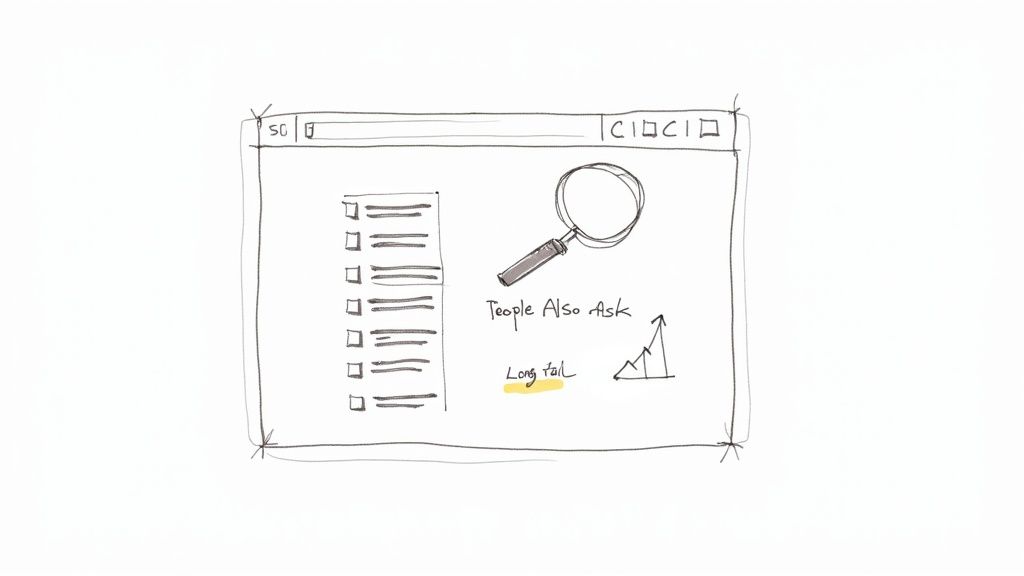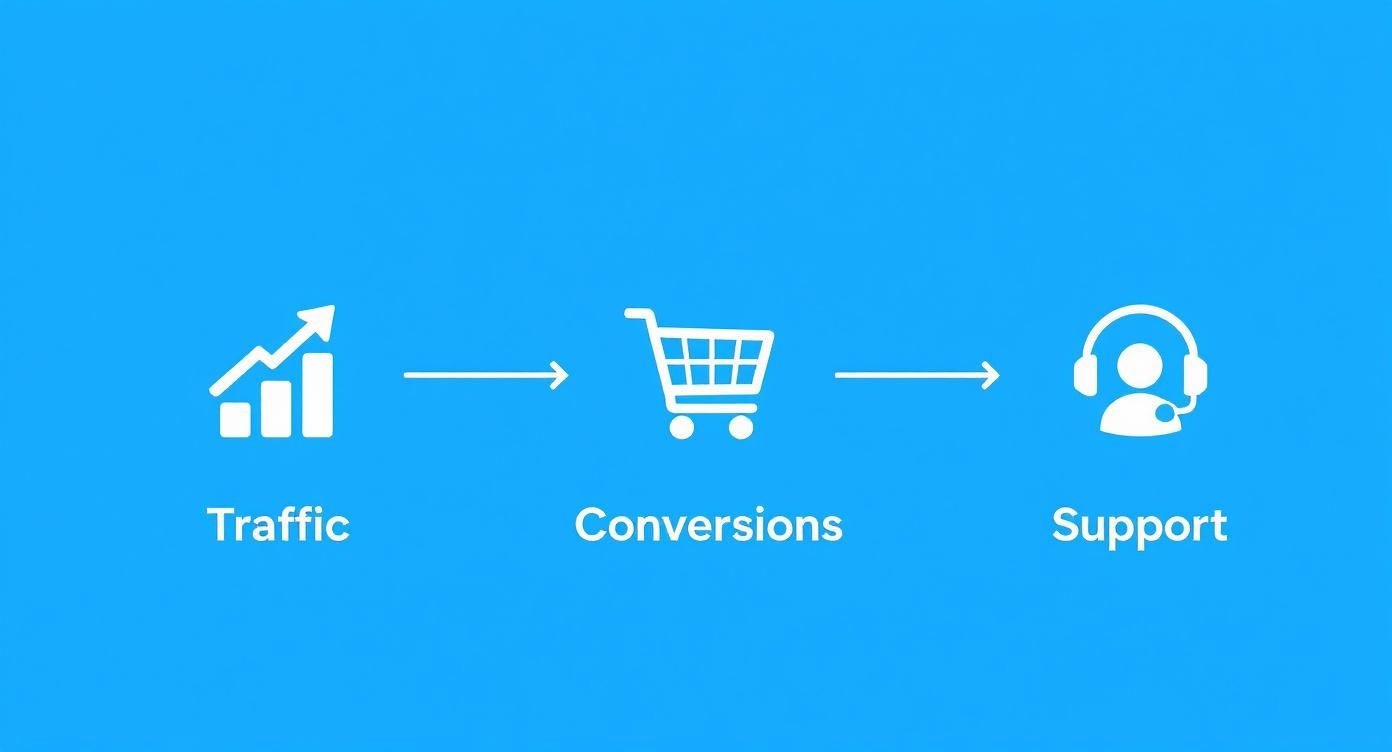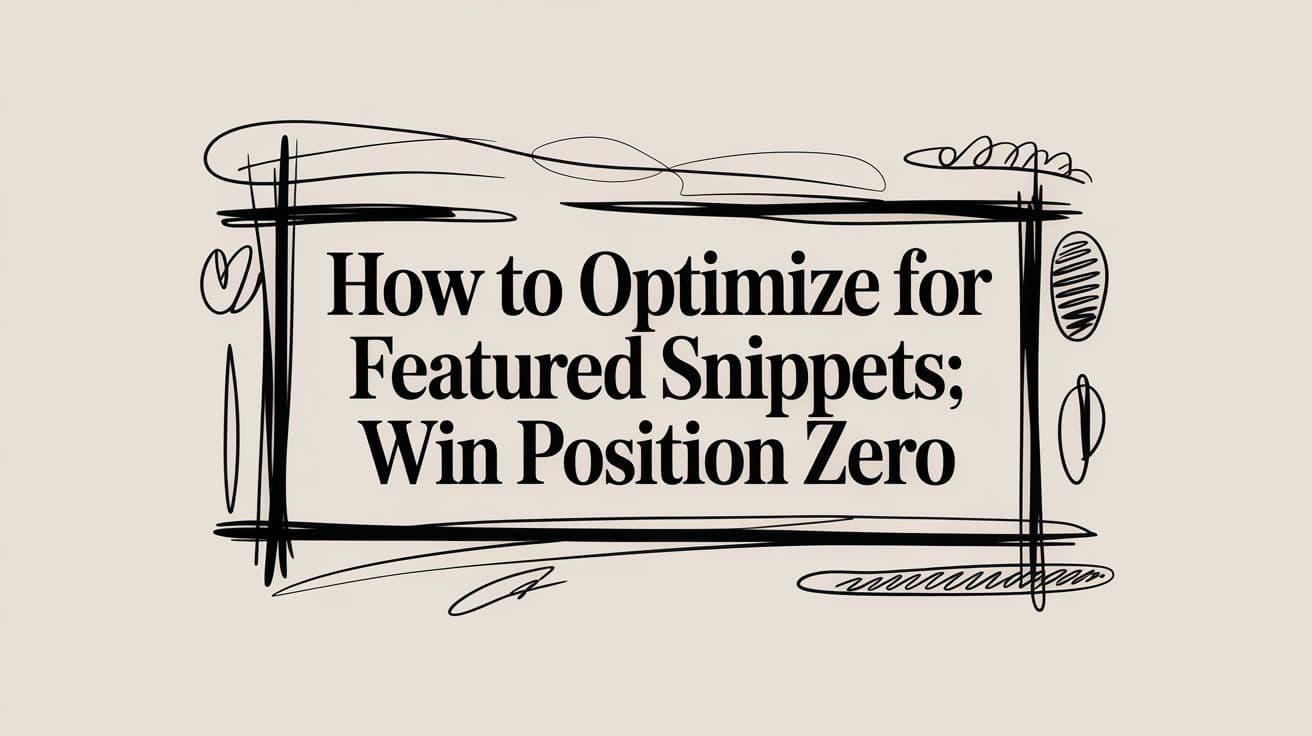Optimizing for a featured snippet isn't a dark art. It’s about structuring your content to give Google a clear, direct answer to a user's question. When you make it easy for Google to pull your text into that "Position 0" box, you win.
This comes down to using the right tools: clear headings, short paragraphs, lists, and tables that mirror the format of the snippet you're trying to capture.
Why Bother with Snippets in an AI World?
The SERPs are chaotic. With AI Overviews taking up more space, many marketers are questioning if featured snippets are worth the effort anymore.
The answer is yes, but their role has changed. The skills you sharpen chasing snippets are now the bedrock of modern SEO and visibility in AI answers.

This isn't just about winning a specific box on the page. It's about signaling to Google that your content is the most authoritative and well-structured answer available. This is a core part of the fundamental concepts of Search Engine Optimization.
The New Reality of Snippets and AI
AI-powered answers have shaken things up. Some reports showed an 83% drop in featured snippets in certain categories after AI Overviews rolled out. As of mid-2025, only a fraction of the old snippets remain active.
The old playbook of "target snippet, win snippet" is dead.
Here’s the counterintuitive part: the underlying strategy is more critical than ever. The core principles of snippet optimization—clarity, structure, and directness—are exactly what Google's AI models look for when they construct answers.
Optimizing for a featured snippet is no longer just about winning "Position 0." It's about training Google to see your content as a primary source, making it more likely to be cited in AI Overviews.
Think of it this way: every time you structure content to win a snippet, you make it machine-readable. You’re creating the perfect, pre-packaged building blocks for an AI to grab and use.
Why the Core Skills Still Drive Results
When you master snippet optimization, you gain an advantage that extends beyond one SERP feature. It forces you into content habits that are essential for long-term success.
- You learn to answer questions directly. You give the answer upfront, which makes both users and search algorithms happy.
- You master structured data. You become skilled at using headings, lists, and tables to organize information—a non-negotiable skill for search visibility.
- You signal authority and trust. Clean, well-organized content feels more credible to search engines, which can lift your rankings across the board.
For example, a SaaS company with a detailed article on "how to calculate customer lifetime value" can add a crisp, 50-word paragraph defining the formula right under a relevant H2.
Even if an AI Overview appears instead of a classic snippet, that clear definition is a prime candidate to be included. This is how you improve your overall AI search visibility—by applying snippet principles. The goal has shifted from owning a snippet to becoming a citable source for AI.
How to Find High-Value Snippet Opportunities
Winning a featured snippet starts with finding the right targets. Forget generic advice. The best opportunities are often hiding one layer deeper than what your competitors are looking at.
Stop guessing and start targeting keywords with clear informational intent—especially the questions your audience asks before they make a decision. This isn't just about traffic; it's about capturing high-intent users at a critical moment.

This data from Ahrefs confirms a critical point: 99.58% of snippets come from pages already ranking in the top 10. That’s why you should focus on finding opportunities within your existing top-ranking content. It’s about optimization, not starting from scratch.
Mine the People Also Ask Boxes
The “People Also Ask” (PAA) section is a goldmine. Google is handing you a list of related questions it knows searchers have. Use them as a content roadmap.
Start by searching for one of your main target keywords. Then, click on a few PAA questions. The list will expand, revealing a tree of user queries you can answer directly.
Actionable Tip: I use a tool called AlsoAsked to automate this. It maps out all the PAA questions visually, showing you how topics connect. This gives you a ready-made outline for an FAQ section or a new article.
Use Your SEO Tool to Find Question Keywords
Your existing keyword research tool is more powerful than you think. Instead of just sorting by volume, filter for questions. Both Ahrefs and Semrush let you isolate keywords containing modifiers like "what," "how," or "why."
Here’s a simple workflow in Ahrefs’ Site Explorer:
- Enter your domain and go to the Organic Keywords report.
- Apply a filter to show only keywords where you rank in positions 2-10.
- Add another filter for keywords that include "what," "how," "why," "where," or "when."
This list shows you the exact questions people are asking where you are already on page one but don't own the snippet. These are your lowest-hanging fruit.
The goal is to identify queries where you have ranking authority but lack the specific formatting to win the snippet. Often, a few tweaks—like adding a concise paragraph or a bulleted list—are all it takes to jump from position #3 to position #0.
Focus on High-Intent Long-Tail Keywords
Most featured snippets are triggered by long-tail keywords—longer, specific search queries. They’re often question-based and signal a user who is further along in their research. For practical insights, check out these 10 Long Tail Keywords Examples to Boost SEO.
Someone searching for "SaaS pricing" is browsing. Someone searching for "what is the best SaaS pricing model for a startup" is a perfect snippet opportunity. Answering it well positions you as the expert.
This is a core component of modern AI search optimization, where providing the best answer to a specific question is what gets you cited in AI-generated results.
Mini Case Study: An E-commerce Win
I worked with an online store selling high-end coffee gear. They ranked on page one for broad terms like "espresso machine" but weren't seeing much direct traffic.
Using the question-filter method, they found five high-intent, long-tail keywords they ranked for in positions 4-8, including:
- "how to clean a portafilter"
- "what grind size for espresso"
- "is a dual boiler espresso machine worth it"
They created a dedicated FAQ section on their main category page, with each question as an H3 heading followed by a concise, 40-50 word answer.
Within three weeks, they captured the featured snippet for three of the five keywords. This drove a 12% increase in organic traffic to that page and a measurable lift in sales for their cleaning supplies and premium grinders.
How to Structure Content to Directly Answer Questions
Google rewards clarity, not cleverness. To win a featured snippet, you must make it absurdly easy for the algorithm to find and lift a direct answer from your page. This isn't creative writing—it's tactical content design.
The best way to do this is with the 'answer-first' methodology. Instead of a long wind-up, you deliver the core answer immediately after the relevant heading.

This approach gives Google's crawlers exactly what they want: a fast, authoritative response. By placing a tight, factual summary right at the top, you’re serving it up on a silver platter.
Create the Perfect Paragraph Snippet
Paragraph snippets are the most common type, making up over 70% of all featured snippets, according to a 2020 study by Semrush. The sweet spot for these is a punchy paragraph of 40-50 words. That length is just right for Google to display without truncation.
This direct-answer format has held its value for years. Data showed featured snippets appeared in 19.2% of search results by 2025, according to a recent report. They grab attention and can pull in up to 8% more traffic than a standard organic listing. You can dig into more of these featured snippet statistics on MyCodelessWebsite.com.
Your goal is to write a definition so clear it could be dropped into a dictionary. Ditch opinions, fluff, and brand jargon. Just state the facts cleanly.
Once you’ve provided that snippet-ready answer, then you can use the rest of the section to add details, examples, and nuance. The direct answer hooks Google, and the deep-dive explanation keeps the human reader engaged.
Use HTML to Signal Structure
Plain text won't cut it. You need to use basic HTML formatting to show search engines the structure of your content. Think of headings, lists, and tables as signposts for Google's crawlers.
- Headings (H2, H3): Frame your headings as questions that match your target queries. An H3 titled "What Is a Snippet Inversion?" directly targets that question.
- Lists (
<ul>,<ol>): When explaining a "how-to" process or listing items, use ordered (<ol>) or unordered (<ul>) list tags. Google loves pulling these directly into list-based snippets. - Tables (
<table>): If you're comparing features, pricing, or data, a clean HTML table is your best friend. Google often lifts entire tables for comparison queries.
This isn't about complex code. It's about using the fundamental building blocks of a webpage to create a logical hierarchy that both people and algorithms can understand instantly.
Case Study: Snippet Inversion in Action
A B2B software blog was trying to capture the snippet for "how to calculate marketing ROI." Their original article was a narrative-style post that buried the formula deep inside the text. They were stuck at rank #4.
The fix was simple. They restructured the top of the article:
- They changed the H2 heading to the exact question: "How Do You Calculate Marketing ROI?"
- Right below it, they added a direct paragraph: "The simplest way to calculate marketing ROI is with the formula: (Sales Growth - Marketing Investment) / Marketing Investment. To get an accurate result, ensure you account for all organic and paid channel costs."
- Then, they used an ordered list to break down each step of gathering the data for that formula.
Within two weeks, they captured the paragraph snippet.
By inverting the structure to lead with the answer, they made their content the clearest response on the SERP. This one change led to a 2.5x increase in CTR for that keyword. This strategy is also a key part of any modern AI search optimization effort, since AI models also favor clearly structured, direct answers.
How to Measure the Business Impact Beyond Clicks
The conversation around featured snippets often gets stuck on clicks. Those metrics are a start, but they barely scratch the surface. The real value of a snippet strategy impacts your bottom line, customer satisfaction, and even operational costs.
When you nail snippet optimization, you're not just playing an SEO game; you're building a more efficient business. You answer customer questions before they contact your support team. You build trust by providing immediate, authoritative answers in the search results.
Snippets as a Revenue Driver
A featured snippet is a direct line to revenue. Capturing a snippet for a high-intent, product-related question puts your brand in front of someone actively looking to buy.
For example, a project management software company won the snippet for "best Trello alternative for small teams." This positioned their product as the immediate answer. After capturing this snippet, they tracked a 15% increase in sign-ups coming from that specific organic landing page over the next quarter. You can find more insights on the financial upside of optimizing for Position Zero on McNeece.com.
Snippets to Reduce Operational Strain
Featured snippets can lighten the load on your customer support teams. Every question a snippet answers is one less ticket your team has to handle. This frees up your support staff to focus on more complex issues.
This is especially true for SaaS and e-commerce companies that get repetitive questions about features, pricing, or shipping. By creating snippet-ready content that addresses these common pain points, you build a scalable, self-service support channel that works 24/7.
Winning a snippet for a common support query like "how to reset my password" or "what is your return policy?" directly reduces your operational overhead. It's a marketing effort that pays dividends in customer service efficiency.
How to Quantify the Full Impact
To get the full picture, you need to track metrics that connect snippet performance to business outcomes. Look beyond what Google Search Console shows you. Connect your SEO efforts to what the C-suite cares about: revenue, costs, and brand growth.
A great way to do this is by tracking your brand’s visibility for key informational queries and correlating it with business KPIs. For a deeper dive, check out our guide on how to approach share of voice measurement in AI search.
Thinking about the full ROI of a strong snippet strategy requires a broader perspective. It's a collection of indicators that show the true value you're creating.
Measuring the Full ROI of Featured Snippets
| Metric | How to Measure | Business Impact |
|---|---|---|
| Conversion Rate Lift | Track goal completions in Google Analytics for users arriving from snippet-winning pages. | Directly ties SEO efforts to sales and revenue generation. |
| Reduced Support Tickets | Correlate the launch of snippet-optimized content with a decrease in ticket volume for related topics. | Lowers operational costs and improves team efficiency. |
| Increased Brand Authority | Monitor branded search volume and direct traffic after capturing high-profile snippets. | Builds long-term brand equity and customer trust. |
| Higher Customer Satisfaction | Survey users about their experience finding information; a good snippet experience often leads to higher satisfaction. | Improves customer loyalty and reduces churn. |
Learning how to optimize for featured snippets is a strategic investment. It’s a business growth activity disguised as an SEO task—driving revenue and making your entire operation run more smoothly.
Your Snippet Optimization Action Plan
Theory is great, but results come from action. This is your go-forward plan. The point is for you to open a new tab with your analytics and start making changes that get you featured.
The difference between ranking #3 and capturing the snippet is often a few focused tweaks, not a massive content overhaul. We’ll start by auditing your existing content to find the fastest wins.
Conduct a Quick Snippet Audit
Your best opportunities are hiding in content that already performs well. You don’t need a huge, site-wide audit to get moving. Just focus on your top-performing pages where Google already sees you as an authority.
Here's a 15-minute audit you can run now:
- Identify Your Top 10 Pages: Go to Google Search Console and find your top 10 organic pages by clicks from the last 90 days.
- Find Their "Striking Distance" Keywords: For each page, look at queries driving impressions where your average position is between 2 and 10.
- Manually Check the SERPs: Open an incognito window and search for 3-5 of those "striking distance" keywords. Does a featured snippet appear? Who owns it, and what is its format (paragraph, list, table)?
This quick check will give you a handful of high-priority targets. You're hunting for existing rankings you can upgrade to Position Zero.
The fastest path to a featured snippet is by improving a page that Google already trusts. By focusing on pages ranking in positions 2-10, you're working with content that has already cleared the authority hurdle. Now it's a matter of structure.
Rewrite a Paragraph to Be Snippet-Ready
Once you have a target, the next step is a surgical content edit. Your goal is to give Google an irresistible, perfectly-formatted answer to pull.
Let’s say you identified the keyword "how to calculate customer retention rate" where you rank #4, and a competitor holds the paragraph snippet.
Here’s how a simple rewrite can make all the difference:
- Original (Buried Answer): "Understanding customer retention is key for business growth. Many factors influence it, but at its core, you need to look at your customer numbers over a specific period. Our company has found that tracking this metric monthly provides the best insights. To calculate it, you first determine the number of customers at the end of a period..."
- Rewrite (Snippet-Ready): "To calculate customer retention rate, use the formula: [((Number of Customers at End of Period - Number of New Customers Acquired) / Number of Customers at Start of Period)] x 100. This calculation gives you the percentage of customers you retained over that time frame."
The rewrite is a direct, 47-word definition that stands on its own. It’s factual, concise, and immediately useful—the perfect recipe for a paragraph snippet.
This infographic visualizes how winning snippets can directly boost traffic, conversions, and even reduce customer support inquiries.
 The insight here is that the value of a snippet extends far beyond a click, impacting operational efficiency and revenue.
The insight here is that the value of a snippet extends far beyond a click, impacting operational efficiency and revenue.
Set Up Tracking to Monitor Your Wins
You can't improve what you don't measure. After making edits, you need a system to track your progress. While you can manually check SERPs, a dedicated tool brings consistency.
Using a platform like our AI SEO Tracker, you can monitor specific keywords to see if your optimization efforts capture the snippet. Set up a project to track your target keywords and get alerts when your ranking changes.
This is critical because snippets are volatile; you can win one today and lose it tomorrow. Continuous monitoring allows you to defend your positions and react quickly if a competitor rolls out a better-optimized page.
Your next step is to apply this plan to one page. Find one opportunity, rewrite one paragraph, and set up tracking. That's how you start winning.
Common Questions About Featured Snippets
Getting these details right is often the difference between nabbing that coveted top spot and just missing it.
How Long Does It Take to Get a Featured Snippet?
There's no magic number, but it’s often faster than you think, especially if you're working with a page that already has authority.
For a page already ranking on page one, a well-placed edit can land you a snippet in as little as a few days to a couple of weeks. Google just needs to recrawl the page and see that your answer is now clearer than the current winner. If you're creating content from scratch, be patient—the page must earn its ranking before it can compete for a snippet.
Can I Lose a Featured Snippet Once I've Won It?
Absolutely. You should expect to. Snippets are volatile, and you can lose them overnight for a few common reasons.
- A competitor out-optimizes you: Someone might create a clearer or better-formatted answer.
- Google's algorithm changes: A core update can shift how Google interprets a query's intent, causing the snippet to change or disappear.
- Search behavior evolves: The way people search for information changes, and Google’s results adapt.
This is why ongoing monitoring is non-negotiable. Winning a snippet is only half the battle; defending it requires constant vigilance.
Does Schema Markup Help Get Featured Snippets?
This is a point of confusion. While Schema is critical for other rich results (like FAQ accordions or review stars), there is no direct evidence that it’s a primary factor for winning traditional paragraph, list, or table snippets.
Your focus for these should be on clean, simple HTML.
Think of it this way: Schema tells Google what your content is (e.g., this is a recipe). Clean HTML formatting—like headings and lists—shows Google what your content says and how it’s organized. For classic snippets, the structure is what matters.
Instead of getting lost in complex JSON-LD, double down on making your H2s, H3s, <ul> lists, and <table> elements as clear as possible. That straightforward approach is what delivers for Position Zero.
Ready to see where you stand in AI-driven search? AI SEO Tracker shows you exactly where your brand appears in AI answers and uncovers the high-intent questions your customers are asking. Stop guessing and start measuring your visibility in ChatGPT, Gemini, and more. Discover your AI ranking opportunities today.

